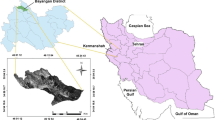Abstract
Forest density expressing the stocking status constitutes the major stand physiognomic parameter of Indian forest. Density and age are often taken as surrogate to structural and compositional changes that occur with the forest succession. Satellite remote sensing spectral response is reported to provide information on structure and composition of forest stands. The various vegetation indices are also correlated with forest canopy closure. The paper presents a three way crown density model utilizing the vegetation indices viz., advanced vegetation index, bare soil index and canopy shadow index for classification of forest crown density. The crop and water classes which could not be delineated by the model were finally masked from normalized difference vegetation index and TM band 7 respectively. The rule based approach has been implemented for land use and forest density classification. The broad land cover classification accuracy has been found to be 91.5%. In the higher forest density classes the classification accuracy ranged between 93 and 95%, whereas in the lower density classes it was found to be between 82 and 85%.
Similar content being viewed by others
References
Anonymous 1983Nationwide mapping of forest and non-forest areas using Landsat False Colour Composite for the period 1972–75 and 1980–82, National Remote Sensing Agency, Hyderabad, Technical Report, vol. 1, pp 1–36
Anonymous 1993Rehabilitation of Logged over Forests in Asia/Pacific region. Final Report of Sub Project II International Tropical Timber Organization — Japan Overseas Forestry Consultants Association, pp 1–78
Anonymous 1995 The State of Forest report, Forest Survey of India, New Delhi, pp 1–82
Botkin D B, Estes J E, McDonald R M and Wilson M V 1984 Studying the Earth’s vegetation from space;BioScience 34 508
Campbell G S and Normal J M 1989 The description and measurement of plant canopy structure; inPlant canopies: Their growth, form and function (eds) G Russell, B Marshall and P G Jarvis (Cambridge: Society of Experimental Biology, Cambridge University Press) pp 1–19
Champion H G and Seth S K 1968A Revised Survey of Forest Types of India (New Delhi: Government of India Publication)
Crist E P and Cicone R C 1984 A physically based transformation of thematic mapper data—The TM Tasseled Cap;IEEE Trans. Geosci. Remote Sensing 22 256–263
Curran P J 1980 Multispectral remote sensing of vegetation amount;Proc. Phys. Geogr. 4 315–341
Gates D M, Keegan H J, Sehleter J C and Weidner V R 1965 Spectral properties of plants; Appl. Optics4 11–20
Houghton R A and Woodwell G M 1981 Biotic contributions to the global carbon cycle: the role of remote sensing;Proc Seventh International Symposium on Machine Processing of Remote Sensed Data, West Lafayette, Indiana, pp 593–602
Jarvis P G and Leverenze J W 1983 Productivity of temperate, deciduous and evergreen forests; inPhysiological plant ecology IV. Ecosystem processes: Mineral cycling, productivity and man’s influence (eds) O P Lange, P S Noble, A. B Osmond and H Ziegler (New York: Springer-Verlag) pp 32–57
Kauth R J and Thomas G S 1976 The tesseled cap—a graphic description of the spectral temporal development of agriculture crops as seen by Landsat; inProc. Machine Processing of Remotely Sensed Data, Purdue University. West Lafayette, Indiana, pp 41–51
Malila W A, Lambeck P F, Crist E P, Jackson R D and Pinter P J Jr 1981 Landsat features for agricultural applications; inProceedings of the Symposium on Remote Sensing of the Environment, Ann Arbor, Michigan, pp 793–803
Malingreau J P 1991 Remote Sensing for Tropical Forest Monitoring: an overview; inRemote Sensing and Geographical Information Systems for Resource Management in Developing Countries (eds) A S Belward and A. R Valenzuela (Dordrecht: Kluwer) pp 253–278
Maslekar A R 1974 Remote Sensing and its scope in Indian Forestry;Indian For. 100 192–201
McCloy K R 1980 Application of Landsat to mapping grassland condition in the South East Region of South Australia;Soil Conservation Branch Report, S1/80, S A Department of Agriculture, Adelaide pp 1–28
McCloy K R and Hall K A 1991 Mapping the density of woody vegetative cover using Landsat MSS digital data;Int. J. Remote Sensing 12 1877–1885
Norman J M and Jarvis P G 1975 Photosynthesis in Sitka Spruce(Picea sitchensis Bong. Carr.) V. Radian penetration theory and a test case;J. Appl. Ecol. 12 839–878
Porwal M C, Dabral S L and Roy P S 1994 Revision and updating of stock maps using remote sensing and Geographic Information System (GIS);Proc. ISRS Silver Jubilee Symposium, Dehradun, pp 334-342
Roy P S, Kaul R N, Sharma M R and Garbyal S G 1985 Forest type stratification and delineation of shifting cultivation areas in eastern part of Arunachal Pradesh using Landsat MSS data;Int. J. Remote Sensing 6 411–418
Roy P S, Diwakar P G, Vohra T P S and Shan S K 1990 Forest Resource Management using Indian Remote Sensing Satellite data;Asian-Pacific Remote Sensing J. 3 11–22
Roy P S 1993 Remote Sensing for Forest Ecosystem Analysis and Management: inEnvironmental studies in India (ed.) M Balakrishnan (New Delhi: Oxford and IBH) pp 335–363
Roy P S and Ravan S A 1994 Habitat Management for Biodiversity Maintenance using aerospace remote sensing; inTropical ecosystems: A synthesis of tropical ecology and conservation (eds) M Balakrislman, R Borgstrom and S W Bie (New Delhi: Oxford and IBH) pp 309–345
Tiwari K P 1978 A comparative evaluation of landuse and forest type classification and mapping with aerial photograph vis a vis conventional ground stock mapping—a case study in Tehri Garhwal;Indian For. 104 747–767
Tomar M S 1976 Use of aerial photographs in working plans;Indian For. 102 98–108
Wu J K, Zheng Q F and Wang W T 1985 A forest inventory using Landsat imagery in the Mao-shan area of China;Int. J. Remote Sensing 6 1783–1795
Author information
Authors and Affiliations
Rights and permissions
About this article
Cite this article
Roy, P.S., Sharma, K.P. & Jain, A. Stratification of density in dry deciduous forest using satellite remote sensing digital data—An approach based on spectral indices. J Biosci 21, 723–734 (1996). https://doi.org/10.1007/BF02703148
Received:
Revised:
Issue Date:
DOI: https://doi.org/10.1007/BF02703148




